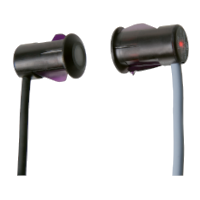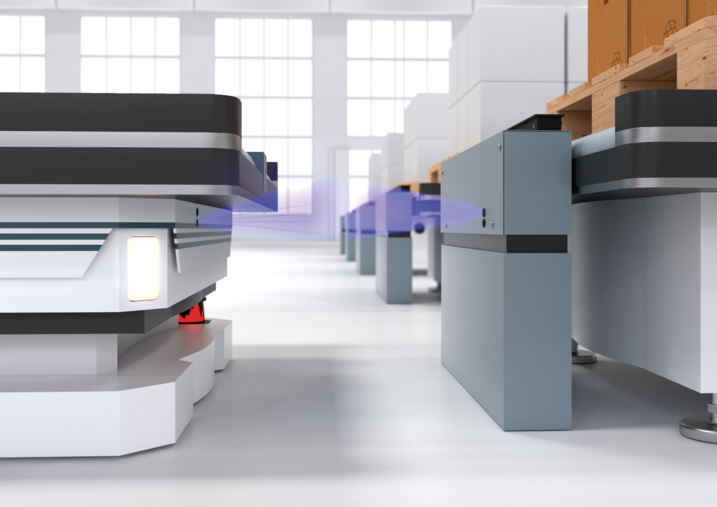Reliably Transferring Materials to Transfer Stations Using AMRs
Thru-Beam Sensor with Large Opening Angle for Strong Signal Transmission

The Application
Autonomous mobile robots (AMRs) transport goods from one location to another as part of production and warehouse logistics. At transfer stations, the goods are automatically loaded and unloaded onto the AMR. Often, several stations are located next to each other. First, the AMR must dock securely at a station to ensure a smooth and safe transfer of the goods carrier. During the transfer, simple but robust signal transmission between the AMR and the transfer station is required to control the loading and unloading direction.
The Goal
The focus here is on creating a robust signal transmission connection for controlling the loading and unloading process. The connection must also function reliably if there are metal structures in the surrounding area that could interfere with the communication channel between the AMR and the loading station. In some cases, there may also be a requirement to confirm that the AMR is transferring signals with the right loading station. This will help the AMR recognize its target position as quickly and easily as possible. Irrespective of the AMR’s path, the light signal from the transmitter must arrive at the receiver element in advance—even if the vehicle is not correctly aligned or if there are vibrations caused by factors such as slight bumps on the route. The light spot of a standard thru-beam sensor would be too small for this task; the AMR would not find its position every time. A standard thru-beam sensor system would also be unable to compensate for movements while the vehicle is stopping or for changes in position due to uneven ground.
The Solution

BB10-P-F1/BB10-P-F2 series
The BB10-P-F1/BB10-P-F2 series of thru-beam sensors provide the ideal complete package. By using two thru-beam sensors, simple two-bit signal transmission can be established to trigger loading or unloading at the transfer station. The first sensor signals the completion of the positioning process and the second sensor triggers the loading or unloading process. The signal transmission can be made completely process-safe by using two thru-beam sensors with different transmission frequencies. This is because cross talk caused by reflections from metal parts can be prevented, even when the sensors are positioned very close together. This communication can also be used to confirm the right transfer station is being used or to find the right transfer station before precisely positioning the AMR. This is made possible by having a transmitter that uses transmission frequency 1 on the AMR, which pairs with receivers using receiver frequency 1 on the transfer stations. By simply activating the receiver of a transfer station, the right transfer station can be confirmed very easily over a long distance using a thru-beam sensor. The receiver on the unused station is simply deactivated because there is no transfer pending. The ideal size of the light spot and receiver opening angle ensures reliable detection, even if the vehicle is not optimally aligned or if there are vibrations affecting the AMR.
Technical Features
- Thru-beam sensor with sensing range of 0 m to 3 m, no dead band
- Large light spot (350 mm diameter at a distance of 3 m) and receiving angle
- Two transmission frequencies
- Infrared light to prevent interference
- Plug-in housing for easy front mounting
- High IP67 degree of protection

The Benefits
The use of two thru-beam sensors is a very space-saving and—above all—cost-effective way of solving the task. The two different transmission frequencies can also be used to advantage: First, the right station is detected using frequency 1. Switching a second pair of sensors to frequency 2 triggers the loading or unloading process. This signal is robust and not affected by interference, unlike AMR wireless communication, which can be impaired in certain areas of environments with many metal components. Regulations for radio communication or bandwidths do not apply. Using two different transmission frequencies prevents cross talk caused by light beam reflections. The devices emit infrared light that is invisible to the human eye, so there are no irritating visual effects.
At a Glance
- Large light spot and large receiving angle ensure that the transfer station is reliably detected
- Strong optical signal connection, no interference from metal components
- Two transmitter frequencies enable parallel operation with additional function
- Infrared light signal is invisible to the human eye and does not cause interference
- Easy front mounting, no bracket required









 +49 621 776-0
+49 621 776-0